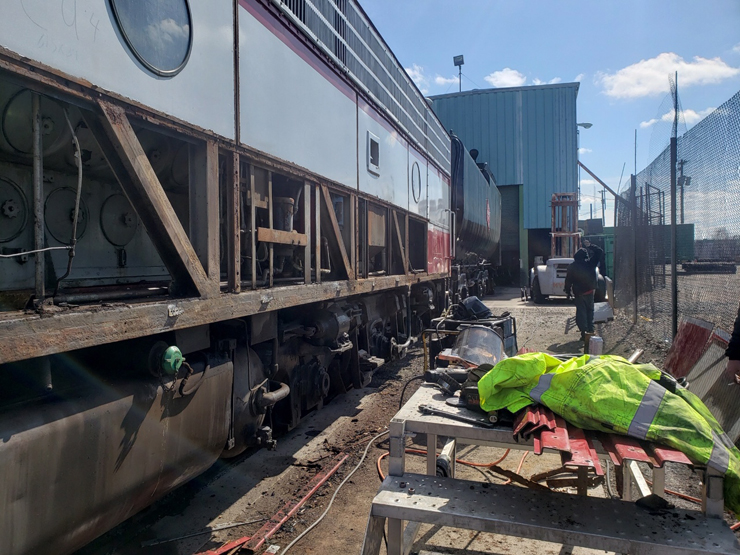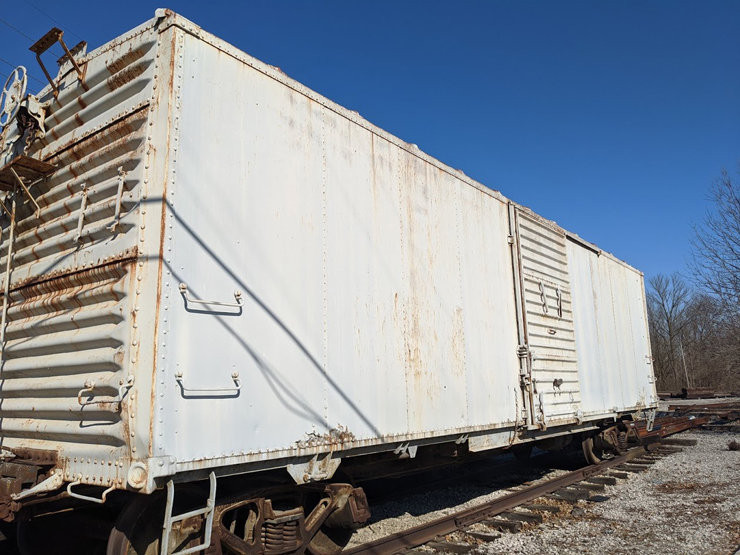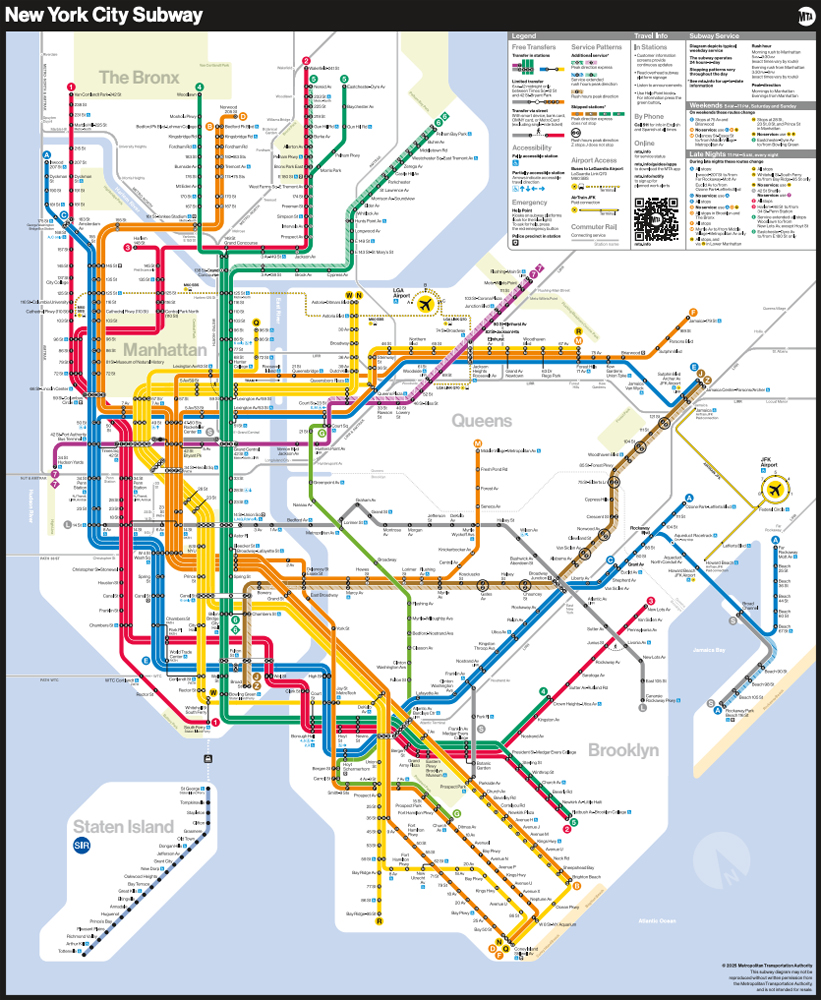While the COVID-19 pandemic dominates the news, railroad museums and the rail preservation community remain active as they find ways to work through the crisis. Here are some examples:
— In Florida, U.S. Sugar Corp. has test fired former Florida East Coast 4-6-2 No. 148, which is undergoing a “ground up” restoration at the company’s locomotive shop in Clewiston. Work began on the project in 2016. ALCO Richmond built the Pacific-type locomotive in 1920. After it spent more than three decades on Florida East Coast, the engine was purchased by the sugar company in 1952. It then worked hauling cars loaded with sugar cane from the fields to a mill at Clewiston. It was an excursion locomotive in the 1970s and saw service in New Jersey before moving on to successive owners in Connecticut, Michigan, and Colorado before bring reacquired by U.S. Sugar. It is one of four surviving FEC 4-6-2s. More information can be found on the locomotive’s Facebook page.
— The John H. Emery Rail Heritage Trust has announced its 2020 grant awards. In addition to the previously reported grant to the Western Maryland Scenic Railroad [see “Canpaign to return No. 1309 to service receives $10,000 grant,” Trains News Wire, March 25, 2020], significant awards include the Erie Lackawanna Dining Car Preservation Society, with a $25,000 award for restoring diner 469/470; Kentucky Railway Museum, receiving $43,000 for firebox and boiler work on Chesapeake & Ohio 2-8-4 No. 2716; and the San Bernardino Railroad Historical Society, with $20,000 for restoring Santa Fe passenger cars 1636 (Pine Lodge) and 1639 (Pine Peak) to Amtrak operational standards. A complete list of the awards is available here.
— The Wabash Valley Railroad Museum is teaming with CSX Transportation to preserve a 98-year-old New York Central boxcar. Weather permitting, the boxcar is to be moved from its current location in Greencastle, Ind., to Terre Haute, Ind., on Tuesday. The car, NYC No. 155524, was built by American Car & Foundry in 1922, rebuilt with steel sides in 1939, and placed near the NYC depot in Greencastle for storage use in 1965. Destined for scrap, it was instead donated to the museum by CSX. The Hailey Tower Historical & Technical Society, which owns the museum, is seeking tax-deductible donations to offset the $15,000 cost of moving the car and building a display track. Donations can be made at the museum website or by mail to the Haley Tower Historical & Technical Society, P.O. Box 10291, Terre Haute, IN 47801.
— In Minnesota, while the Lake Superior Railroad Museum in Duluth is closed, the museum is offering daily 5-minute video tours on its You Tube channel and Facebook, highlighting different exhibits and stories of railroading hosted by Executive Director Ken Buehler. You can see the tours here.
— Also in Minnesota, the Friends of the 261 is continuing work on its former Milwaukee Road E9A 32A. Rusted side panels are being removed and replaced with new metal. The Friends recently received a donation of a modern event recorder, speed sensor and alerter system. They hope to install them and paint the locomotive in Milwaukee Road colors this spring, virus permitting.
— The National Railroad Museum in Green Bay, Wis., has set up a Virtual Activity Zone for school age children that can be done from home. For example, for Middle School children there are topics such as “Big Boy Locomotive Math” and “Name the States – The Big Boy Locomotive Route.” There are also visual story times and crafts. More information is available at the museum website.
— The Baltimore & Ohio Railroad Museum in Baltimore has launched “B&O Train Talk,” a daily sharing of images and videos from its collection and archives every day on its Facebook, Instagram and Twitter accounts. The museum is also providing educational and train-related stories and learning projects twice weekly for children. These “Junior Junction” specials, feature Director of Education Rebecca Funk and air on Tuesdays and Thursdays each week via Facebook, Instagram, Twitter, and the museum website.















It is possible that Steve Sandberg and the “Friends” are thinking long term about motive power and consist to create a Hiawatha lookalike to operate somewhere, somehow. Having non-Milwaukee equipment to trade is wise strategy. A worthy organization to support…one of many nowadays.
Looking at the B & O Museum comment, how can something be “broadcast” when over-the-air transmission is *not* involved?
When I first saw the picture of Milwaukee Road E9 No. 32A in a state of disassembly, I thought I was viewing a massive structure similar to Houston’s George R Brown Convention Center with exposed frames and portholes. Then my sight adjusted to the images which turned out to be a dismantled E9 locomotive with porthole panels still intact.
Full skirting, coupler covering (if it existed) and rear sprung diaphragm should be restored to No. 32A. Ditch lights would be distracting to the locomotive’s vintage appearance and can be omitted.
32A would be covered under 49 CFR 229.133 if it is actually equipped with a Gyra light. This is the section of the safety code for interim auxiliary lights.
EVERYCLICK.COM
Gerald,
I will stand corrected on this if someone is more conversant with the federal railroad administration rules, but I believe if the unit is equipped with a Gyra light (not a Mars light) then it can operate without ditch lights above 25 mph. 32A does have a Gyra light.
Penelope Vinson,
DItch lights can NOT be omitted from the 32A, if there are no ditch lights then the unit could NEVER lead a train and would forever be subjected to trailing status, as I’m pretty sure the FRA doesn’t grant waivers for diesels that would traverse mainlines and they’re required for anything built after 1948..